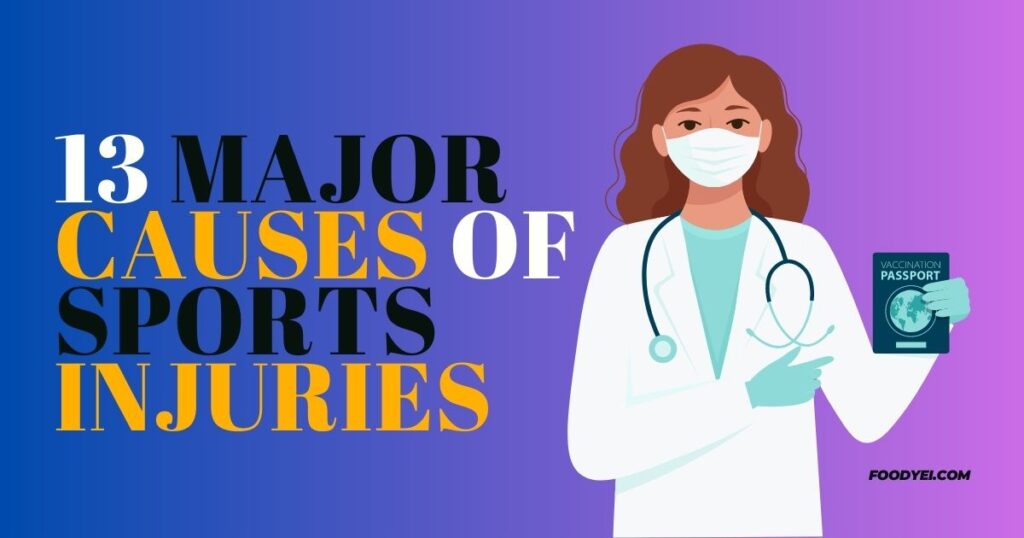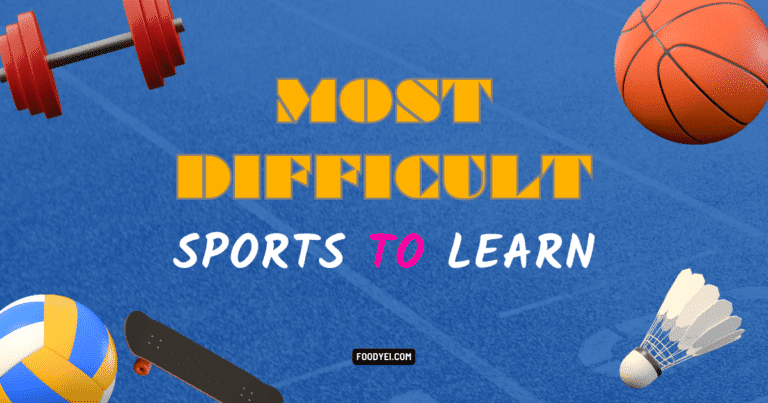Sports injuries can develop due to a range of circumstances, ranging from inadequate training and bad technique to overuse and accidents. Understanding the causes of sports injuries is vital for athletes, coaches, and healthcare professionals to limit the risk and promote safe participation in sports activities. In this post, we will investigate the common causes of sports injuries and provide insights into how they might be prevented.
13 Major Causes of Sports Injuries

1. Lack of Proper Warm-up and Stretching
One major cause of sports injuries is the failure to warm up appropriately before participating in physical exercise. Warm-up activities enhance blood flow to the muscles, making them more supple and less prone to injury. Additionally, stretching helps increase flexibility and range of motion, minimizing the risk of strains and muscle pulls.
2. Insufficient Conditioning and Fitness Levels
Insufficient conditioning and poor fitness levels might contribute to sports injuries. Athletes who are not in peak physical shape may experience weariness, muscle imbalances, and impaired coordination, making them more susceptible to accidents and injuries. It is vital to progressively improve endurance, strength, and flexibility through specific training programs.
3. Incorrect Technique and Form
Performing sports movements with incorrect technique and form significantly increases the risk of injuries. Whether it’s a faulty golf swing or improper tackling in football, improper biomechanics can place excessive stress on joints, ligaments, and muscles. Coaches and trainers play a vital role in teaching athletes the correct techniques and monitoring their execution.
4. Overuse and Repetitive Stress
Overuse injuries come from repetitive stress on certain body regions. Athletes that engage in activities with repetitive actions, such as sprinting or throwing, are prone to these injuries. Common instances include tennis elbow, runner’s knee, and stress fractures. Proper training programs, break intervals, and cross-training can help prevent overuse injuries.
5. Inadequate Rest and Recovery
Rest and recovery are needed for the body to repair and rebuild after heavy physical exertion. Without appropriate rest, muscles and connective tissues become weary and more susceptible to injury. Overtraining and insufficient rest time can lead to chronic injuries and poor performance. Athletes should prioritize sleep, rest days, and active rehabilitation measures like stretching and foam rolling.
6. Environmental Factors
Sports injuries can be influenced by environmental factors such as weather conditions and playing surfaces. Slippery or uneven surfaces increase the danger of falls, while severe temperatures can lead to heat-related diseases or frostbite. Athletes and event organizers should consider these aspects and take proper procedures to ensure safety.
7. Equipment Failure or Inadequate Gear
Using incorrect or inadequate sporting equipment can lead to injury. Malfunctioning gear, such as a broken helmet strap or a worn-out shoe sole, might threaten an athlete’s safety. It is vital to constantly inspect and maintain sporting equipment to ensure its efficacy and replace worn-out gear promptly.
8. Poor Playing Surfaces
Playing on poorly maintained or inadequate surfaces might contribute to injury. Uneven fields, slippery courts, or artificial turf with insufficient padding increase the risk of falls, sprains, and joint injuries. Proper field upkeep and selecting adequate playing surfaces help minimize these risks.

9. Lack of Protective Measures
Protective equipment such as helmets, padding, mouth guards, and goggles are needed in particular sports to prevent injury. Neglecting to wear suitable protective gear exposes athletes to avoidable hazards. Coaches, parents, and athletes themselves should emphasize safety equipment and assure correct utilization.
10. Fatigue and Dehydration
Fatigue and dehydration can decrease an athlete’s performance and increase the probability of injuries. When the body is weary or dehydrated, reaction times go down, coordination gets hampered, and muscles are more prone to strains and cramps. Staying adequately hydrated and managing fatigue through enough rest and nutrition is crucial for injury prevention.
11. Psychological Factors
Psychological problems might also contribute to sports injury. Stress, worry, and loss of attention can lead to failures in concentration and coordination, increasing the risk of accidents. Sports psychology approaches such as visualization, relaxation exercises, and mental preparation can assist players maintain a focused and confident mindset.
12. Age and Growth-related Issues
Young athletes, particularly those in growth phases, may endure specific injuries connected to their age and development. Growth plates, which are areas of growing cartilage, are more sensitive to fractures and overuse injuries. Age-appropriate training, good supervision, and steady evolution of activities are critical for limiting these dangers.
13. Previous Injuries and Weaknesses
Athletes who have undergone past injuries or have underlying vulnerabilities are more susceptible to re-injury. Failure to address these difficulties through suitable rehabilitation and strengthening activities might lead to chronic problems. Rehabilitation treatments should focus on restoring strength, stability, and optimal movement patterns to limit the chance of re-injury.
Conclusion
Sports injuries can occur from numerous factors, and recognizing their causes is vital for injury prevention. Proper warm-up, conditioning, technique, and rest are key parts of injury prevention. Athletes, coaches, and healthcare experts should work together to promote safe sports participation by applying preventative techniques and focusing the athletes’ well-being.
FAQs
1. How can I prevent sports injuries?
Prevent sports injuries by warming up properly, utilizing the right technique, wearing suitable protective gear, and gradually developing fitness levels. Additionally, prioritize rest, recovery, and cross-training.
2. What should I do if I sustain a sporting injury?
If you incur a sports injury, it is crucial to obtain appropriate medical assistance. Rest, ice, compression, and elevation (RICE) can be applied initially to minimize discomfort and swelling. Follow your healthcare provider’s guidance for accurate diagnosis, treatment, and rehabilitation.
3. Are there any specific sports more prone to injuries?
Certain sports, such as football, soccer, basketball, and gymnastics, have greater injury rates due to their physical demands and contact nature. However, accidents can occur in any sport if necessary measures are not taken.
4. How significant is strength training for injury prevention?
Strength training plays a critical role in injury prevention by enhancing muscle strength, joint stability, and overall physical performance. It helps guard against common sports injuries and boosts athletic performance.
5. Can psychological variables affect the risk of sports injuries?
Yes, psychological variables can affect the risk of sports injuries. Stress, worry, and lack of attention can lead to lapses in concentration and coordination, increasing the probability of accidents and injury. Maintaining a focused and confident mindset through sports psychology approaches like as visualization, relaxation exercises, and mental preparation can help lessen the chance of injury.




